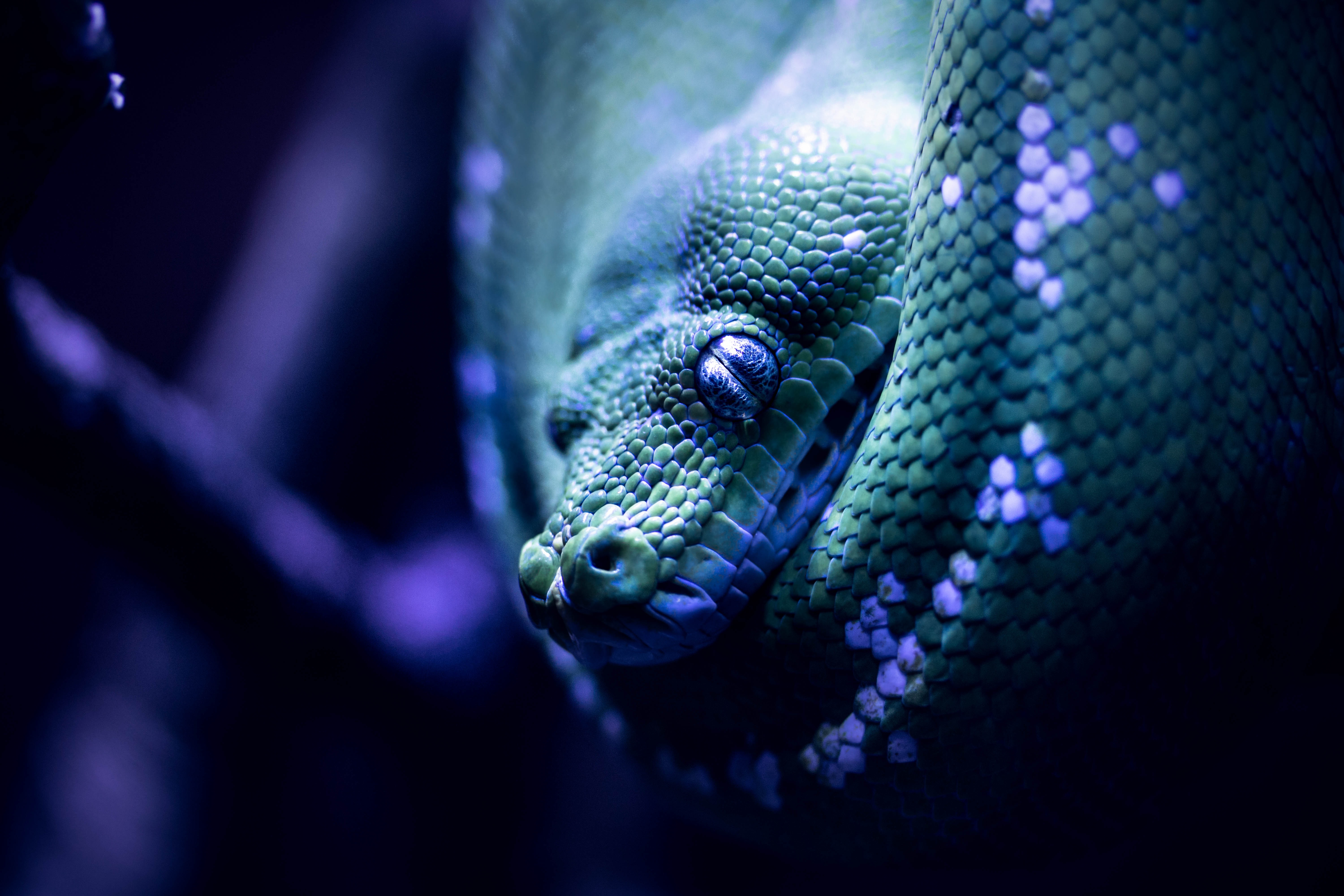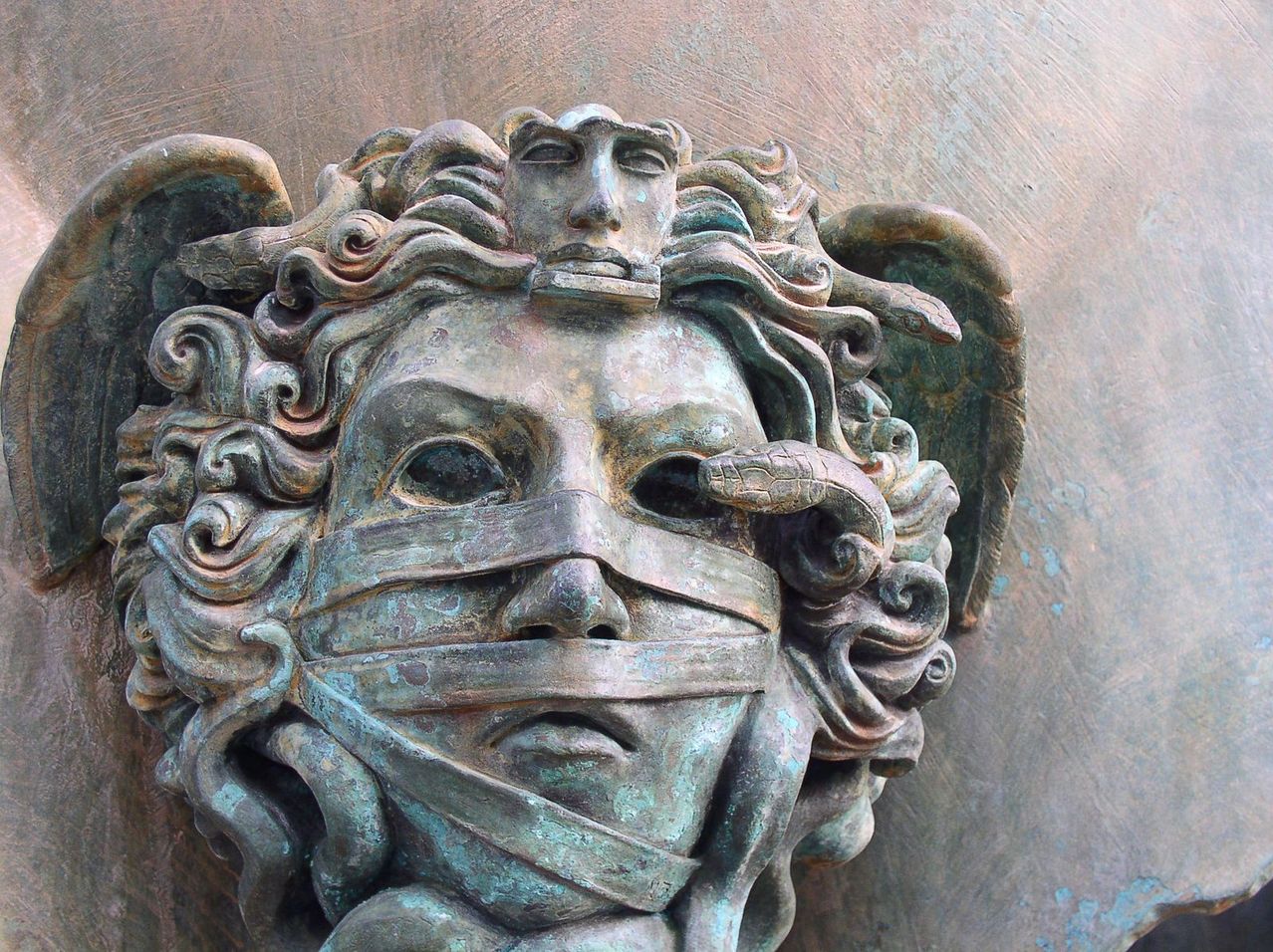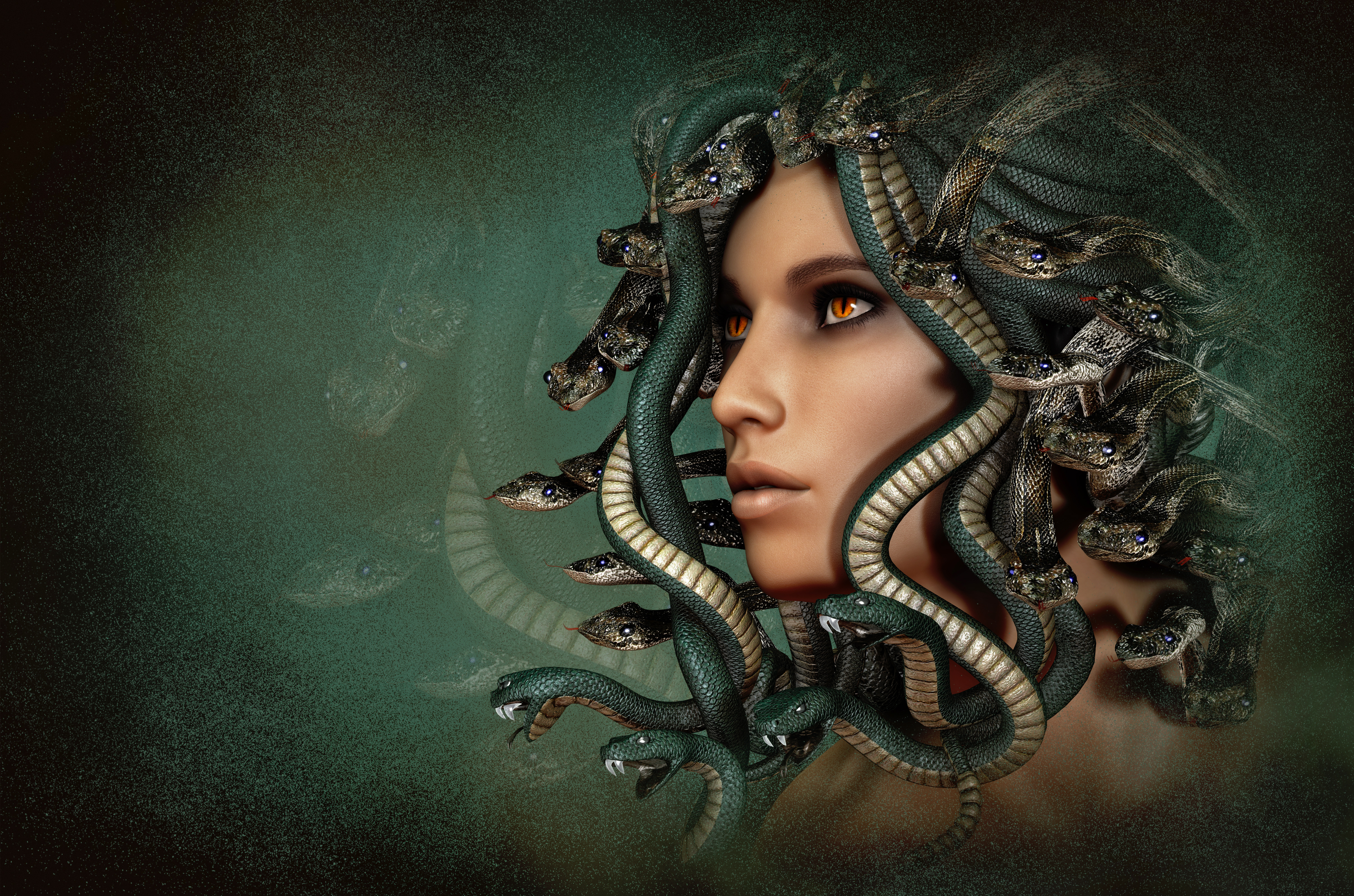Medusa Staring Contest
A snap behind a nearby tree catches her attention. The figure, scaled and fanged, lowers her most recent catch, a field mouse, from her lips. Another, tentative snap. It sounded too big to be a fox. Too small for a stag. Unlikely to be another gorgon; they don’t move through her location with such trepidation.
She crouches down amongst the ferns. The damp leaves cling to her scales like hands exploring the mountain ranges of her skin. A black ribbon of flesh snaps out of her mouth, tasting the musky damp air tinged with the aroma of moist leaves. Slit eyes dart between the ferns and trees to catch a glimpse of glinting copper between trunks.
A hoplite. Armed with spear and a reflective shield. His helm gives him the appearance of a tentative rooster exiting his pen for the first time. The shiniest human she has ever laid eyes upon. Perhaps if she doesn’t move, he will simply pass through. Most humans do.
But not this human. He is searching. Wading through the forest and mud, prodding each suspicious fern, which is every one, with the tip of his spear. He approaches. Too close. The gorgon instinctively bares her fangs towards the intruder. He does not see until ten paces away. Gasping, he raises his shield. She sees herself in the shield, face barely noticeable between the leaves save for her white fangs.
Still, he does not leave her territory. He readies his spear. She rears up, tensing her jaw and neck muscles to bring her “hair” to life while she lets out a hiss. Last warning.
The hoplite lowers his shield just enough to aim his weapon. She lets loose her venom into his eyes.

So, I did a bit of a click-baity title. We won’t actually be talking about Medusa, per say…
Medusa, the legendary creature of Greek Mythology, is actually the name of one of the three gorgons. Traditionally, the Gorgons were monstrous serpentine sisters born to Echidna and Typhon, all with reptilian features and withering snake hair. Of the sisters, only Medusa was mortal.
Or, the first gorgon was Medusa, a beautiful woman who was sexually assaulted by Poseidon in Athena’s temple (or seduced him, it depends on the retelling), and then was punished by Athena who transformed her into the gorgon we know and love. Women in Greek myths tend to get really crappy treatment, if you ask me.
Now, you’ll notice that I am not exactly citing any particular works here, and that is because there are a huuuuge amount of sources of Greek myths online. Surprisingly, Wikipedia is a good place to look to get a general overview and where to start your search on the gorgon mythos. And, we’re not here to retell the story of Medusa, we’re here to tack some science to the mythos. And boy-howdy, did I have a ball with this one, folks!
Are Gorgons Mammals?

To keep true with the Greek mythos, no. Even if we’re considering the “human to reptile” origin story, Greek mythos still explicitly states Gorgons are reptilian in nature. Gorgons, for purposes of the blog, are not mammals. This has large implications for both gorgon physiology and society as a whole.
That means NO MAMMARY GLANDS. I get it; it’s an easy way to show that a creature is a female to an audience, but I cannot stress enough how silly is to see non-mammals have breasts in commonly consumed media.
There is a whole discussion right now in the RPG community about “putting breasts on snake-people” and how anyone can “make their snake-lady any way they want,” but I cannot stress enough how ridiculous this trend it. There are many ways to show sexual dimorphism; you do not need to just tack on breasts to show this dimorphism because… let’s be real here… people are just sexualizing the non-human character when they do that. Can we please move away from “breasts= womanhood”?
(I actually had a whole aside here ranting on the inappropriate tendency to use breasts to define womanhood in our culture, but I’ll save it for another post)
This also means that they are cold-blooded, or ectotherms. Mammals are endoderms, meaning that they can regulate their own body temperatures. Our gorgons, on the other hand, will have to rely on the environment to regulate their activity levels. If gorgons are social creatures, this will affect where they can build their society, and when/how they collect food. No artic climates for these creatures. Perhaps they build their buildings on natural hot springs so they can have naturally heated floors. Or their sleeping arrangements change during the winter so that gorgons can huddle with one another to stay warm. Most likely, their settlements would be built in areas with ample sunlight, or they have clever ways of harnessing the heat of the sun; perhaps by painting their shelters black to absorb more sunlight during the day during the winter? In any case, gorgons would need some way to combat the cold of the night in order to protect their settlements, so keep that in mind while developing gorgon society.
Fun fact: ectoderms also do not burn nearly as many calories as endoderm’s! They can do more with less, which would change their culinary delights compared to human meals.
Would they lay eggs or have live births? Snakes can do both, but since we’re basing some of our hypothetical gorgon on cobras (see below), let’s assume that they lay eggs like cobras. This actually has huge implications, as laying eggs (coupled with the lack of mammary glands) would take the burden of childbearing and rearing off of the female almost entirely. Womanhood, if the concept of gender exists at all in gorgon society, could potentially not be so heavily linked to child rearing. This would mean the female and male leave the eggs to incubate and hatch on their own, which would require gorgon society to have a system in place specifically to raise these children (These gorgons are becoming more and more socialist as this post progresses). Maybe there are egg incubating houses. Maybe there are specific members of society that have taken on the duty of feeding and teaching the newborn. Maybe the parents are like pythons and do take care of their own newborns, making family units. Or maybe there are multiple types of gorgon societies, each with unique practices. The possibilities are endless!
Are they sentient like a human? That is up to you, fellow writer! Me personally, I would make them have comparable intelligence to humans. I like the idea of having a species that has evolved in parallel with humans over the centuries. That way I could also worldbuild their culture and society, which I always have a ball doing.
Bad Hair Day

Medusa’s hair is traditionally comprised of writhing snakes, warping themselves around her head and snapping to attention to warn their prey with a symphony of hisses. In short, a gorgon’s hairdo has snakes capable of moving and acting on their own.
I don’t think this can work in real life. Each snake having its own central nervous system on the gorgon’s head AND its own mouth is just complicated. Having multiple heads under the control of one central head won’t really work either. Human conjoined twins have to work together to coordinate the body: no one twin is in charge. Snakes with polycephaly have been known to try to kill each other, but according to this article, one head does tend to be more developed than the other and they do coordinate to an extent. But that’s all with two heads, people. Having 10+ on one body? Ridiculous. And how would the digestive system work?!?
But that’s only if we assume those snakes are real. You heard me: those snakes don’t actually have to be real to be effective. I am envisioning them to be the equivalent of tails on the gorgon’s head that, upon contraction of muscles, would have them begin to move. From a distance, this would give the gorgon the appearance of having a head full of live snakes. And this would be exceedingly terrifying deterrent for any potential predator who won’t be getting any closer to check if those “snakes” are real.
Having a bluff mechanism is actually very common in reptiles. This snake the hooded malpolon has a similar look to a cobra, despite the fact that the snake itself is not deadly venomous (although their bites still hurt like heck). Some snakes play dead like the eastern hognose snake. The bull snake imitates the coloration and the rattling behavior of rattlesnakes, and so on and so forth.
The point is, having a bluffing mechanism is actually in line with the gorgon’s reptilian ancestry!
Gorgon Speech
The anatomy of the primate tongue and mandible (jaws) gives us the ability of speech. (The scientist magazine).
Do we assume gorgons have the same affinity for speech as we do? If we assume that gorgons were originally of human origin (see Medusa’s Poseidon and Athena origin), sure. That wouldn’t be too much of a stretch They’d have similar jaws, aka “mandibles,” similar tongue structures, basically an all-around human mouth, based on their inherited genetics.
…But that’s not as much fun! We’re assuming more serpentine origins in this post!
Let’s talk about the mandibles: In order to look humanoid, we have to say that the jaw structure is slightly similar to a primate’s, despite normal reptiles lacking a chin. We’ll have to assume that, in order to form a similar facial structure, the gorgon jaw will have developed a kind of chin (this is important for speech). Would it have as much range of motion as a primates? Sure, although it’s a unique form of motion as snakes can separate their lower jaw into left and right halves to increase their “gaping mouth” size, combined with their flexible jawbone thanks to ligaments attaching it to their skull (according to australasianscience.com).
Let’s also assume that gorgon’s mouth does also consist of teeth in likeness of most lizard species, not just a few fangs like a snake. This will make things more interesting.
Would our gorgon have tongues similar to ours? As much as I want to say “no” and give our creature a thin forked tongue, we’ll see that we actually do need a pretty dexterous and malleable tongue for gorgon speech to work. And a diaphragm/lung combo like ours. Let’s assume they have that.
Does a gorgon have a hard and soft palate? First, let’s examine the importance of the hard and soft palate in human speech. If you haven’t really felt how your tongue interacts with the hard roof of your mouth, now would be a good time because many of the sounds, like “duh,” “tuh,” or other “plosive” sounds. You tongue interacts with the hard surface of the mouth moreso than your teeth. Your soft palate, on the other hand, elevates to create oral sounds, such as your vowels or most “voiced” consonants. Snakes have no secondary palate (which would be our hard palate). Without a hard palate to separate the nasal passages and the mouth during speech, the gorgon’s speech will sound “nasally”. Let’s assume the gorgon has a soft palate, though, and so has the capability of distinguishing between vowel sounds and can still make noise by passing air through their oral cavity.
Would the lips of the gorgon be as dynamic and dexterous as a primate’s? Nope. They wouldn’t be able to pucker up lips, making the “o” and “u” sounds really hard to do, and would be impossible if their tongues couldn’t reshape itself in their mouths to modulate some of the outgoing sound in some way. But they could still use their lips to make sounds and could even use them in the place of a hard palate (it would be more difficult for sure: try making the “tuh” and “duh” sounds right now using just your tongue and the back of your lips).
Have I oversimplified the study of linguistics? Absolutely. But the more I went down this “speech” path, the deeper and deeper the rabbit hole went and the longer it was going to take to get this post out! There was an entire section on the physiology of the vocal chords and elasticity of the lungs that we’re not touching, nor the number of phenomes that the human mouth itself can make and how that would work for a gorgon
Anyway, this boils down to: if the gorgon has a tongue that is more akin to ours, they may be able to mimic a lot of human speech, but it would be quite difficult. With what we’ve built so far, actually having a speech that is reliant on vowel sounds, clever use of stiff lips, and, surprisingly or not surprisingly, hissing, could be just as complex as any human speech in the world.
…Or they speak French. A lot of French.*
So About That Gorgon Gaze…

Ok, so here comes the hard part: the “petrifying stare” of Medusa.
There is no scientific equivalent to turning flesh to stone. There really isn’t. That’s honestly not physically possible to alter all of your organs at a molecular level to that of stone, let alone with just a stare.
Instead, let’s take the “petrifying” part less literally. What we want is a mechanism that paralyzes/stops the target in its tracks.
I was thinking of a mechanism where there could be a chemical under the reptilian skin that lets the gorgon’s face light up (similar to fireflies) and flash in a way that causes seizures for any onlooker, but the issue here is that the light needs to be reeeeeaaaaally bright in order to use that trick, and there’s just no way that phosphorylating chemical could be bright enough. Plus, it would probably affect the gorgon’s vision as well (which would suck) and alert any other creatures in the area (double suck).
Let’s look back at the animal kingdom again: what mechanisms do creatures use to target prey from afar?
That’s where we find the spitting venom snakes. You may have heard of spitting cobras; these creatures can shoot up to 4-8 feet according to this. Since the gorgon is larger and could have access to larger muscles to project their venom, we can assume this distance is increased significantly for a “spitting gorgon.”.
Fantastic! We have our ranged attack! But now we need to ascertain the contents of the venom itself. A quick check on Wikipedia tells us that the venom is made up of cytotoxins and can really only hurt you if you get it in your eyes (which, as it could cause permanent blindness, is still suboptimal).
Cytotoxins are defined by their name: cyto= cell, toxin= poison. So, poison to cells, meaning that the venom goes in and destroys cells at the site of injection, rather than causing your entire immune system to seize up. Don’t get me wrong; my platelet-studying self loves some venoms that can cause blood clotting and loss of heart function, but that’s not entirely what we want for the gorgon’s paralyzing effect. But who says we can’t change this to a different venom? Let’s make it a neurotoxin like mambas, specifically dendrotoxin! Dendrotoxins block neuronal potassium channels, which are what “shut down” nerve signals. We call this “repolarizing” the neurons. Without the ability to turn off the nerve signal, the nerve releases too much acetylcholine and results in the muscles seizing up. And voila! We have our “paralyzing” ranged attack!
And the fact that the venom only is effective when it enters the mucosal tissue (eyes, mouth, etc) actually fits with the gorgon mythos. Don’t look directly at the gorgon, or there’s a good chance you will get venom in your eyes. Once the venom’s in your system, your muscles will seize up and now you’re a living statue for the gorgon to prey on… or run away from. Let’s be honest, humans are pretty scary and most animals would rather avoid us more than anything.
The Takeaway
I had a BLAST doing this one, guys! So many rabbit holes, so much fun research!
Due to interest in the implications of gorgon society, I will probably be revisiting gorgons in the future to go over more of their social structure and interactions that are influenced by their biology.
Have an idea for a worldbuild post, or a general blog post for science in fiction? Let me know! Until then, keep writing friends, and I will see you next time!
*No offense to French. Gorgeous language. I just have a history with French: I could read and write it in school, but could not for the life of me speak it. It’s a miracle that I passed that class!
